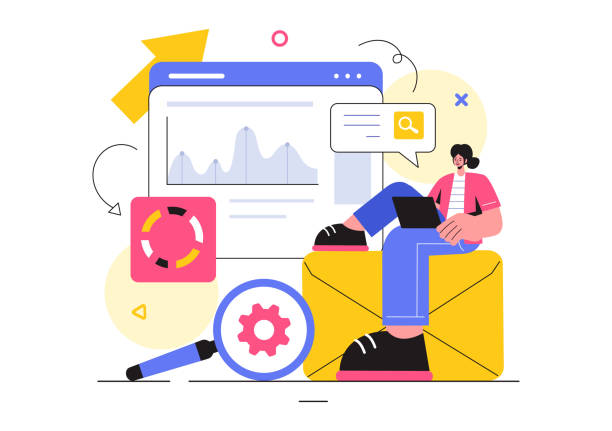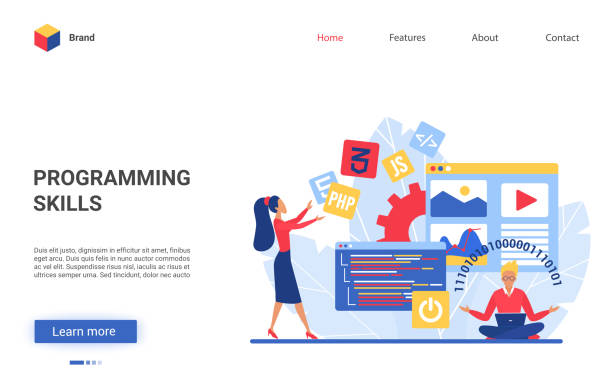Introduction to the Principles of Responsive Web Design and its Importance

Responsive web design (#responsive_web_design) is a crucial approach in today’s web world, aiming to provide an optimal user experience across a wide range of devices, from large desktops to small smartphones.
In this approach, the website’s layout and content automatically adapt to the user’s screen size.
This means there’s no longer a need to develop separate versions for mobile and desktop; a single website can appear beautifully and function correctly on any screen size.
The importance of responsive web design is more evident than ever in this era, where users access the internet through various devices.
According to global statistics, a significant portion of web traffic comes from mobile, and this trend continues to grow.
A website that does not adapt well to these changes not only provides a poor user experience but also falls behind in competition with other websites.
This educational approach helps users gain a deep understanding of the fundamentals of this modern web design method.
The core concept is based on the use of flexible grids, fluid images, and Media Queries, which allow developers to apply styles based on device characteristics (such as screen width or orientation).
These techniques enable a website to have a professional and efficient appearance in any environment and meet visitors’ needs in the best possible way.
Tired of your company’s website not being seen as it deserves, losing potential customers? Solve this problem forever with professional and effective website design by Rasawp!
✅ Increase brand credibility and attract customer trust
✅ Attract targeted sales leads
⚡ Contact us now for a free consultation!
Why is Responsive Design a Necessity? (Challenging and Analytical Content)

In today’s fast-paced world, the fundamental question is: Is responsive web design merely a luxury choice or an unavoidable necessity? The unequivocal answer is that it’s no longer a choice, but rather the cornerstone of online success.
From the perspective of User Experience (UX), users expect websites to be easily navigable and their content well-displayed, regardless of the device they use.
A website that requires zooming, horizontal scrolling, or excessive vertical scrolling on mobile quickly discourages users and pushes them towards competitors.
This directly impacts the Bounce Rate and the user’s time on site.
From an Search Engine Optimization (SEO) standpoint, Google has clearly stated that it prefers responsive websites in its search results, especially for mobile searches.
This means that the lack of responsive web design implementation can lead to a decrease in site ranking and loss of organic traffic.
Furthermore, maintaining a responsive website is significantly simpler and more cost-effective than maintaining multiple separate versions for different devices.
Content or design updates are done only once and applied across all platforms.
This analysis indicates that not only today, but also in the future, websites that adhere to the principles of responsive design will have a significant competitive advantage and the ability to respond to changing user needs.
This is an essential step to ensure accessibility and success in the digital space.
Key Elements in Responsive Web Design (Technical and Explanatory)

To effectively implement responsive web design, understanding its key elements is essential.
These elements include Flexible Grids, Fluid Images, and Media Queries.
Flexible grids use relative units like percentages for element widths instead of fixed pixel units.
This approach ensures that the website layout naturally adjusts with screen size, and content is displayed without breaking or horizontal scrolling.
Similarly, fluid images ensure that images do not exceed their container and scale correctly with screen size changes.
This is typically achieved by setting the max-width: 100% property for images in CSS.
However, Media Queries are the backbone of responsive design.
These CSS commands allow developers to apply specific styles based on device characteristics (such as screen width, height, orientation, or even resolution).
For example, you can define that on screens smaller than 768 pixels, the menu should display as a hamburger menu, and content columns should stack.
These specialized elements work together to provide a seamless and optimized user experience on any device.
Without mastering these concepts, creating a responsive website that truly performs well will be challenging.
Below is a table of common breakpoints (Breakpoints) in responsive design, used for defining media queries.
| Device Type | Approximate Width (pixels) | Description |
|---|---|---|
| Smartphones (Small) | Up to 480px | Single-column display, hamburger menu |
| Smartphones (Medium/Large) | 481px – 767px | More space for elements, slightly larger fonts |
| Tablets (Portrait) | 768px – 991px | Possible two-column layout, dropdown menu |
| Tablets (Landscape) / Small Laptops | 992px – 1199px | Multi-column, full navigation menu |
| Desktop (Normal) | 1200px – 1599px | Standard desktop design |
| Desktop (Wide) | 1600px and above | Optimized space for more content |
Common Tools and Frameworks for Responsive Design (Educational and Guidance)

To facilitate the responsive web design process, numerous tools and frameworks have been developed to help designers and developers create responsive websites with higher speed and efficiency.
One of the most famous and widely used is Bootstrap.
Bootstrap is a CSS, HTML, and JavaScript framework that includes design templates for typography, forms, buttons, tables, navigation, and other UI components, all of which are responsive by default.
Its use significantly accelerates the design and development process.
Another popular framework in this field is Foundation, which prioritizes a “Mobile-First” approach and is suitable for more complex projects.
In addition to frameworks, core CSS technologies like CSS Grid and Flexbox are powerful tools for creating responsive layouts.
Flexbox is excellent for arranging elements in one dimension (row or column) and provides excellent control over space distribution and item alignment.
In contrast, CSS Grid is ideal for more complex, two-dimensional layouts (rows and columns simultaneously) and has revolutionized how web layouts are built.
Learning how to correctly use these tools is essential for anyone intending to work in responsive website design.
Also, responsive testing tools like browser developer tools (e.g., Chrome DevTools) help you simulate your site across different screen sizes and identify potential issues.
This educational guidance will help you improve the implementation process of responsive web design by choosing the right tools.
Does your company’s website create a professional and lasting first impression in the minds of potential customers? Rasawp, with its professional corporate website design, not only represents your brand’s credibility but also opens a path for your business growth.
✅ Create a powerful and trustworthy brand image
✅ Attract target customers and increase sales
⚡ Get a free consultation
User Experience (UX) and Responsive Web Design (Specialized)

The relationship between User Experience (UX) and responsive web design is deep and inseparable.
In fact, the main goal of responsive design is to improve UX.
A responsive website ensures that the user, regardless of the device they are using, has a seamless, smooth, and enjoyable experience.
This includes ensuring text readability, appropriate button sizes for touch interaction, easy navigation, and quick access to information.
The “Mobile-First Design” approach gains special importance in this regard.
Instead of designing for desktop first and then adapting it for mobile, in Mobile-First, designers first design for the smallest screen (mobile) and then gradually add features for larger devices.
This method ensures that the most important content and functionalities are prioritized and optimized for devices with limited resources.
One of the specialized aspects in this area is understanding the needs of mobile users.
Mobile users are often on the go, with internet connections that may not always be stable, and are looking for quick and accessible information.
Therefore, responsive web design must include image optimization, page size reduction, and ensuring fast loading.
Buttons should be large enough to be easily tapped with a finger, and there should be enough space between elements to prevent accidental touches.
It is this attention to detail that transforms a website from merely “responsive” to “providing an excellent user experience.”
Ultimately, investing in responsive web design is an investment in improving UX and consequently increasing user satisfaction, loyalty, and conversion rates.
Optimizing SEO with Responsive Design (Analytical and Guidance)

Responsive web design and Search Engine Optimization (SEO) are two sides of the same coin.
Google, the world’s largest search engine, has explicitly stated that it prefers responsive websites over separate mobile versions (like m.example.com).
The reasons for this preference are clear:
Firstly, a responsive website uses a single URL for all devices.
This means there’s no need to redirect mobile users to a different URL, which helps reduce loading times and prevent crawling issues for search engines.
A single URL also simplifies the management of backlinks and social signals, as all authority is consolidated to one address.
Secondly, responsive design helps Google crawl and index your site’s content more efficiently.
With only one version of the content, Google bots don’t need to crawl and examine multiple versions of a page, which saves crawling resources and improves overall SEO.
Thirdly, the improved user experience that responsive web design provides indirectly affects SEO.
Lower bounce rates, longer time on site, and higher user engagement are all positive signals for Google, indicating the quality and relevance of your content.
Google considers these factors in its ranking algorithms.
This comprehensive analysis shows that responsive web design is no longer just a competitive advantage, but a fundamental element for success in modern SEO.
Investing in it means investing in your website’s greater visibility in search results.
Challenges and Solutions for Responsive Web Design (Specialized and Guidance)

Despite its countless advantages, responsive web design is not without its challenges.
One of the biggest concerns is performance and loading speed on mobile devices.
Although the goal of responsive design is to improve user experience, if not properly optimized, it can lead to slow page loading, especially on slower mobile networks.
The solution to this challenge lies in precise image optimization (using appropriate formats like WebP, compression, and the srcset attribute for responsive images) and lazy loading of non-essential resources.
Another challenge is managing complex content and data tables on small screens.
Large tables can become unusable on mobile.
Solutions include converting tables into horizontally scrollable cards, hiding less important columns on mobile, or displaying data as organized lists.
Testing and debugging can also be complex, as it requires examining the website on various devices and screen sizes.
Using browser simulation tools (like Chrome DevTools) and cloud testing platforms like BrowserStack is essential.
Navigation management is also a common challenge; large desktop menus must be converted into more compact formats like hamburger or accordion menus on mobile.
This specialized guidance helps you anticipate these challenges and implement appropriate solutions for a successful and efficient responsive web design.
Below is a table of responsive testing tools.
| Tool Name | Type | Features and Use |
|---|---|---|
| Chrome DevTools | Browser Tool | Simulate various devices, change screen width and height, touch testing |
| Responsinator | Online Tool | Simultaneous display of website on multiple popular device sizes |
| BrowserStack | Cloud Testing Platform | Test website on hundreds of real devices and browsers, live debugging |
| Am I Responsive? | Online Tool | Visual display of website on desktop, laptop, tablet, and mobile |
| Google Mobile-Friendly Test | Google Tool | Check site compatibility with mobile from Google’s perspective and provide a report |
The Future of the Web and the Role of Responsive Design (News and Analytical)

Responsive web design not only addresses the current needs of the web but also plays a fundamental role in shaping the future of the web.
With the emergence of new technologies like Progressive Web Apps (PWAs), websites are evolving towards applications that offer a user experience close to native apps.
Responsive design is the foundation of this transformation, as PWAs also need to adapt to a wide range of devices and screen sizes.
Furthermore, with the expansion of Internet of Things (IoT) devices and new user interfaces like Voice UI and Augmented Reality (AR), websites and applications must be able to present content in different formats that go beyond traditional displays.
In these scenarios, the principles of responsive web design also apply to laying out and presenting content in these dynamic environments.
This news analysis indicates that the web is moving towards an increasingly pervasive and multifaceted environment.
A website that can seamlessly function across a large desktop screen, a smartphone, a smart TV, and even a smartwatch (with different user interfaces) will be successful in this future.
The concept of “Design Once, Deploy Anywhere,” which originates from the principles of responsive web design, is key to this adaptability.
Therefore, focusing on responsive web design principles is not only essential for today but also vital for ensuring preparedness for the future challenges and opportunities of the web.
This approach ensures that your online presence is optimized and accessible anytime, anywhere.
Does your current website build the trust that potential customers should have in your business? If the answer is no, it’s time to have a professional and impactful corporate website with Rasawp.
✅ Fully custom design tailored to your brand identity
✅ Increased lead generation and business credibility in the eyes of customers⚡ Contact us for a free consultation!
Golden Tips for Successful Responsive Web Design (Guidance and Educational)

To achieve truly successful responsive web design, adhering to a few key tips is essential.
This educational guide will help you avoid common mistakes and achieve the best performance.
-
Adopt a Mobile-First approach: As mentioned earlier, design for the smallest screen first, then gradually add features for larger devices.
This helps you focus on core content and critical functionality. -
Choose breakpoints wisely: Instead of using standard breakpoints, determine them based on your content and when your layout needs adjustment.
This way, your content will look optimized at any size. -
Optimize images: High-volume images can severely slow down your site.
Use modern image formats (like WebP), compression, and the HTMLsrcsetattribute to deliver appropriately sized images to each device. -
Consider touch space: Ensure that buttons, links, and other clickable elements are large enough and have sufficient spacing between them for mobile users to easily interact with them.
-
Test, test, test: Regularly test your website on actual devices and various simulators to ensure its correct functionality across all sizes and operating systems.
This is a critical step for stable responsive web design. -
Prioritize content: On smaller screens, you may need to hide less important elements or reorder them to make the most crucial information easily accessible.
Following these golden tips will pave your way to building a responsive website that is both beautiful and efficient.
Optimizing Performance in Responsive Web Design (Specialized and Guidance)

One of the aspects of responsive web design that is often overlooked but extremely vital is Performance Optimization.
Even if a website correctly adapts to different screen sizes, if it loads slowly, it severely disrupts the user experience.
Mobile users, in particular, expect high speed and will quickly leave the site if there’s a delay.
To ensure excellent performance in responsive design, there are several specialized solutions:
Firstly, code compression (CSS, JavaScript, and HTML).
By removing whitespace, comments, and shortening variable names, file sizes are significantly reduced, leading to faster loading.
Secondly, optimizing and compressing images as the largest factor in page size.
Using lossless compression tools and modern formats like WebP can reduce image sizes by 50% or more.
Also, implementing Lazy Loading for images and videos is essential, meaning content is only loaded when the user scrolls to that part of the page.
Thirdly, using browser caching to store static files on the user’s device.
This makes the website load much faster on subsequent visits.
Fourthly, reducing HTTP requests by combining CSS and JavaScript files and using Sprite Images for icons.
These actions not only improve website loading speed but also directly positively impact site SEO, as page speed is an important ranking factor for Google.
Therefore, attention to performance optimization alongside responsive web design is the key to your website’s success in today’s world.
Frequently Asked Questions
| Question | Answer |
|---|---|
| What is Responsive Web Design? | A method of web design that makes a website display well on various screen sizes and devices (such as mobile, tablet, desktop) and provides an appropriate user experience. |
| Why is responsive design important? | Improved user experience, better SEO (Google prefers responsive sites), time and cost savings (no need to build separate mobile sites). |
| What are the main techniques in responsive design? | Using flexible grids and layouts (Fluid Grid), flexible images and media (Flexible Images), and using Media Queries in CSS. |
| What are Media Queries in responsive design? | A part of CSS3 that allows you to apply different styles based on the characteristics of the device on which the website is displayed (such as screen width, resolution, media type). |
| What are the benefits of using responsive design? | Access to more users (especially mobile), improved user engagement rate, reduced maintenance costs (one site for all devices), and improved conversion rate. |
And other services by Rasawp Advertising Agency in the field of advertising
- Smart Advertorials: A fast and efficient solution for campaign management focusing on custom programming.
- Smart Social Media: Professional optimization for increased sales using Google Ads management.
- Smart Marketing Automation: A blend of creativity and technology for digital branding through intelligent data analysis.
- Smart Link Building: A specialized service for SEO ranking improvement based on Google Ads management.
- Smart Brand Identity: Professional optimization for increased website traffic using user experience customization.
And over a hundred other services in the field of internet advertising, advertising consulting, and organizational solutions.
Internet Advertising | Advertising Strategy | Advertorials
Resources
Responsive Web Design on IranHostThe Importance of Responsive Design by RayavandAn Article on Responsive Design on VirgoolResponsive Web Design Guide by Webramz
? Ready to revolutionize your business in the digital world? Rasawp Afarin Digital Marketing Agency, by offering comprehensive and innovative solutions, accompanies you on the path to success. For sustainable growth, from **modern UI website design** to SEO strategies and targeted advertising campaigns, contact us.
📍 Tehran, Mirdamad Street, next to Bank Markazi, Southern Kazeroun Alley, Ramin Alley, No. 6



